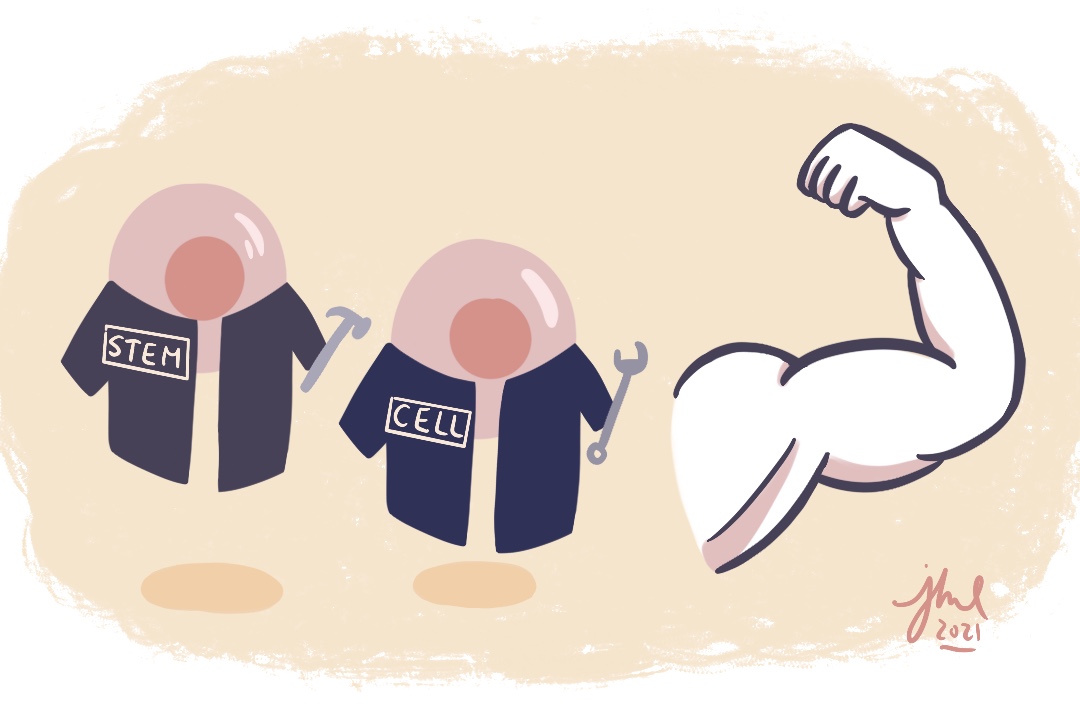Many existing tests to develop drugs within the field of regenerative medicine are time-consuming, cumbersome, and fail to mimic the physiological environment in human bodies. Recently though, a joint project between U of T’s Biomedical Engineering Faculty members Dr. Alison McGuigan and Dr. Penney Gilbert created an innovative way to manipulate and evaluate the regenerative capacity of muscle stem cells.
Two researchers from Gilbert’s lab, post-doctoral fellow Dr. Sadegh Davoudi and PhD student Bella Xu, discovered a new method to do so that circumvents common shortcomings. This novel approach not only has the potential to expedite the drug discovery processes but can also accelerate the development of regenerative medicines for muscles.
Background on the regenerative process in muscles
Muscles are critical for maintaining normal body functions. They keep us upright, carry us around, and support our breathing. They also have remarkable regenerative abilities. Minor injuries can heal by themselves without therapeutic intervention. Most of us have experienced this self-repair phenomenon firsthand with minor sprains and strains.
The regenerative process in muscles, also known as muscle endogenous repair (MEndR), occurs thanks to a reservoir of stem cells that are activated following an injury. The stem cells then proliferate and remodel the damaged muscles during the healing phase.
In the case of more severe injuries, such as injuries from traumatic accidents and muscle atrophy, stem cells alone are not enough to regenerate muscles. This limitation results in the formation of scars and non-functional tissues.
In the field of regenerative medicine, MEndR is considered a promising focus of study for researchers that want to identify compounds that can amplify stem cells’ capacity to repair and to improve self-healing. Although the process may sound simple theoretically, it is much more complicated in practice.
Davoudi, the U of T paper’s lead author, wrote in an email to The Varsity that the existing methods “often do not have the necessary regenerative cues and the readouts are simplistic.”
“Furthermore, the animal models are complicated, expensive, time consuming, ethically questionable, and most importantly not human,” Davoudi added. However, the newly discovered technique found by Davoudi and Xu, which uses MEndR, might solve all these issues.
Streamlining regenerative therapies development
Davoudi’s and Xu’s technique combines both the screening and validation stages of drug development into a single step on a petri dish, which could significantly accelerate the drug discovery pipeline. Davoudi and Xu came up with the idea while working on their own individual projects. Originally, Davoudi was working on identifying new drugs for muscle regeneration while Xu was looking at developing mini-muscle tissues.
Davoudi recalled how this project was inspired, “One day as we were talking as a group, we decided to see what would happen if we added muscle stem cells [to the mini-muscle].” The researchers were excited when the stem cells not only repaired the injured mini-muscle tissues, but also responded to drug treatments the same way that they responded to drugs in animal models. “That was the experiment that led us down the path of creating [the MEndR project],” Davoudi wrote.
The researchers ran a test that involves growing muscle tissues, into which they incorporate muscle stem cells, on a sheet of cellulose paper. Davoudi calls the result a “three-dimensional mini-muscle in a dish.” After that, they treat the muscle tissue with a damaging toxin, mimicking the destruction of muscles from a snake bite.
What Davoudi and Xu found is that the mini-muscle system reproduces the natural environment needed by stem cells to kickstart MEndR. At this point, researchers can add various compounds to the system and study their effects on stem cells’ regenerative capability.
There are many advantages to using a 3D mini-model compared to traditional model organisms. Davoudi went on to elaborate that, by using the 3D mini-model, the researchers were able to “reproduce the results of drug treatments in animal studies faster, cheaper, and with a higher throughput.” He also added that the simplicity and accessibility of this technique opens up the possibility of studying muscle regeneration in new ways that they couldn’t attempt before because of the limitations of using traditional animal models.
MEndR meets industry
Another promising aspect of this new technique is its potential to be scaled up. One lab can run up to 60 tissues at the same time, allowing for side-by-side comparison of multiple drugs. The amount of time saved because of the efficiency of Davoudi and Xu’s method could make a world’s difference for patients suffering from severe muscle destruction from either trauma or diseases such as Duchenne muscular dystrophy.
Because of this, there has been great interest among researchers over this new method and many groups have contacted Gilbert’s lab. “[We] had several industrial and academic research groups reach out to test their designed compounds in our MEndR assay, and we’re collaborating with them as well,” wrote Davoudi.
To fully implement the use of MEndR in the drug development pipeline, Davoudi wrote that he and Xu are developing a more portable version of their experiment, which will require less time, fewer materials, and less work to use. He added that they’re also working on developing it to be used on human tissue, which Davoudi thinks will enable MEndR’s future potential use as a personalized medicine tool.
Davoudi is very optimistic about the future of his project. “This publication is a first step in creating a fully human system that will allow a personalized medicine approach towards identifying new drugs and treatments for muscle repair in individual patients,” he wrote.


